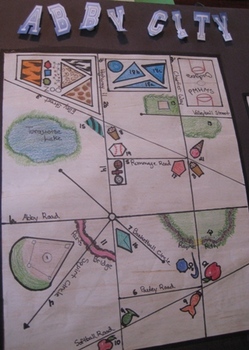Geometry Town Project: Using Geometric Vocabulary to Design a Map
Shawna - Making Math Meaningful
1.9k Followers
Resource Type
Standards
CCSS7.G.B.5
CCSS8.G.A.5
Formats Included
- PDF
Pages
6 pages
Shawna - Making Math Meaningful
1.9k Followers
What educators are saying
This resource was a great way to apply what the students have learned. They enjoyed the activity and I liked how they could work at their own pace.
This was a great resource to use in class! My students were engaged during the activity and I would use it again!
Description
This has been my students' favorite project this year. The whole point is to have students use the geometric terms that they've learned in a creative way. You can use it as a way for students to learn and practice new vocabulary, or as a review project, or even as a culminating project after a unit on geometry.
I have been developing this project over time, and I've worked out many of the kinks. It's not too big, and not too small. Basically, the students have 26 items that need to go on the Map/Town. Some of the items are lines or segments, which are the roads. Once those are placed, then the students need to place particular items in particular angles. For example, they need to put two coffee shops at corresponding angles. Or a bridge connecting supplementary angles.There is a template that has some of the basic lines (roads) already placed. You can use this for ALL of your students if you want them to focus on putting the other items in the correct angles. This would be much easier to grade, since it would be easy to locate all the required items, but it's not as creative. I used it for my inclusion kids. I heard the best academic language between students as they worked on this project - and they seemed to care more about the different types of angles as they did the project.This project includes: An overview, a list of required items, a legend template, grading guidelines, a modified scoring rubric, and photos of my students' work.
Also, Geometry Glossary compliments the project very well:
Geometry: Student Glossary and Vocabulary
Other Geometry Products include:
Volume of Cylinders, Cones, Spheres, and Composite Figures
FREE Scaffolded Notes: Finding the Area of Parallelograms and Trapezoids
Area & Perimeter: Triangle, Parallelogram, Trapezoid, Circle & Composite Figures
Volume of Pyramids, Cones, and Spheres
FREE Area of Rectangles and Trianglese
FREE Angles Angles Angles
FREE Understanding Angles: A Coloring Activity!
FREE Pi Day Cookie Measuring Activity - Discovering Pi
Area and Circumference of a Circle
I have been developing this project over time, and I've worked out many of the kinks. It's not too big, and not too small. Basically, the students have 26 items that need to go on the Map/Town. Some of the items are lines or segments, which are the roads. Once those are placed, then the students need to place particular items in particular angles. For example, they need to put two coffee shops at corresponding angles. Or a bridge connecting supplementary angles.There is a template that has some of the basic lines (roads) already placed. You can use this for ALL of your students if you want them to focus on putting the other items in the correct angles. This would be much easier to grade, since it would be easy to locate all the required items, but it's not as creative. I used it for my inclusion kids. I heard the best academic language between students as they worked on this project - and they seemed to care more about the different types of angles as they did the project.This project includes: An overview, a list of required items, a legend template, grading guidelines, a modified scoring rubric, and photos of my students' work.
Also, Geometry Glossary compliments the project very well:
Geometry: Student Glossary and Vocabulary
Other Geometry Products include:
Volume of Cylinders, Cones, Spheres, and Composite Figures
FREE Scaffolded Notes: Finding the Area of Parallelograms and Trapezoids
Area & Perimeter: Triangle, Parallelogram, Trapezoid, Circle & Composite Figures
Volume of Pyramids, Cones, and Spheres
FREE Area of Rectangles and Trianglese
FREE Angles Angles Angles
FREE Understanding Angles: A Coloring Activity!
FREE Pi Day Cookie Measuring Activity - Discovering Pi
Area and Circumference of a Circle
Total Pages
6 pages
Answer Key
N/A
Teaching Duration
3 days
Report this resource to TPT
Reported resources will be reviewed by our team. Report this resource to let us know if this resource violates TPT’s content guidelines.
Standards
to see state-specific standards (only available in the US).
CCSS7.G.B.5
Use facts about supplementary, complementary, vertical, and adjacent angles in a multi-step problem to write and solve simple equations for an unknown angle in a figure.
CCSS8.G.A.5
Use informal arguments to establish facts about the angle sum and exterior angle of triangles, about the angles created when parallel lines are cut by a transversal, and the angle-angle criterion for similarity of triangles. For example, arrange three copies of the same triangle so that the sum of the three angles appears to form a line, and give an argument in terms of transversals why this is so.





